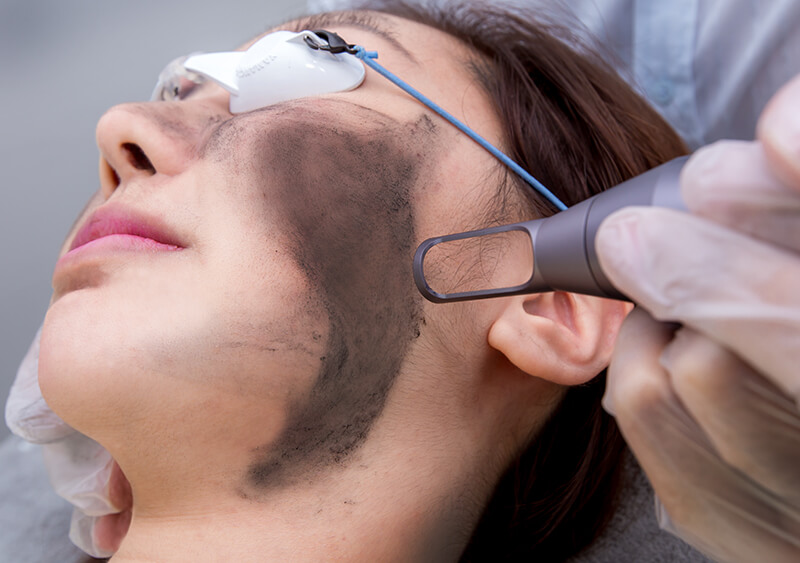Laser Skin Resurfacing (Carbon Skin Rejuvenation) in Bristol
£90 per session or £360 for 5 sessions.
Why choose Pro. Clinics for laser skin resurfacing?
Many people are concerned with the appearance of their skin and are keen to try different methods and techniques that will help to improve the overall appearance of their skin.
Laser skin resurfacing or carbon skin rejuvenation as it is sometimes referred to is an exciting and initiative method of rejuvenating the skin through the use of an advanced Nd Yag laser system.
The treatment is favoured by many celebrities as it instantly gives the skin a natural healthy glow and is quick and painless treatment. Another advantage to the treatment is the lack of downtime, meaning it is the perfect lunch-time facial!
Pro. Clinics are renowned for our aesthetic treatments, and we have many 5 star reviews on the web, so you can be sure that you are in safe hands whenever you book in for a treatment.
Carbon skin rejuvenation or laser skin resurfacing can be used as a ‘one off’ treatment, as it is the perfect facial treatment to have carried out before a special occasion or important event.
Non-surgical cosmetic treatments are rapidly gaining in popularity, and it is easy to see why when the results are so instant and noticeable!

Laser Skin Rejuvenation FAQs
Carbon laser skin rejuvenation or laser skin resurfacing is a very popular, painless and non-invasive laser treatment offered by Pro. Clinics.
The quick and easy procedure is a highly effective method of achieving younger, firmer looking skin by using our medical grade Q Switched Nd Yag laser.
Results are often noticeable after your first session, however it is recommended that a course of 6 sessions will be required in order to achieve the optimum results. Once the full course of 6 sessions has been completed, many clients decide to book top-up sessions once every couple of months, to ensure that their skin maintains its improved appearance.
Carbon skin rejuvenation or laser skin resurfacing as it is sometimes called, is considered to be a very low risk and safe procedure that has little to no down time, meaning it is the perfect treatment to have carried out during a lunch hour or after work!
There are numerous benefits to this quick and inexpensive treatment, including reduced fine lines and wrinkles, shrinking of dilated pores, a reduction in the appearance of acne, scars and post acne discoloration.
The treatment also helps to remove dead skin cells from the superficial epidermal layer of the skin, as well as stimulating collagen growth, improving the overall texture of the skin and clearing the skin’s pores in order to help reduce both blackheads and whiteheads.
As with all of our treatments at Pro. Clinics, we aim to keep our costs as low as possible and charge just £80 per session, or £320 for 5, for this popular treatment.
After thoroughly cleansing the face, the Carbon Paste is thinly applied to the skin. Once the carbon paste has had time to dry on the skin, the clinician will start the process of vaporising the carbon, using light that is delivered from the laser. When the carbon paste is vaporised, it causes a vacuum effect, that sucks debris that is clogging the skin’s pores. This powerful cosmetic Q Switched Nd Yag laser treatment helps to refine enlarged pores which reduces oil secretion and helps to remove blackheads and whiteheads. In addition, the treatment stimulates the skin on the face to produce fresh collagen which helps reduce fine lines and wrinkles.
The treatment is not at all painful and most people actually find the experience very relaxing. There is sometimes a very mild feeling of heat that can be felt during the treatment, but not so hot that the process becomes uncomfortable.
At Pro. Clinics, we usually advise clients that a full course of 6 sessions will be required in order to obtain the optimum results, although you can expect to see some results after your first session. Many people like to book a one off treatment before a special event, such as a party or wedding etc, to ensure that their skin is looking radiant and refreshed.
We have generally found that the best results are achieved when leaving around a week between sessions, although this can vary from person-to-person.
The treatment itself can be completed in only a few short minutes, however around 20 minutes of skin preparation time is required for best results, so allow around 45 minutes for your first session.
There are no side effects to this treatment.
There is no specific aftercare required for this treatment.

